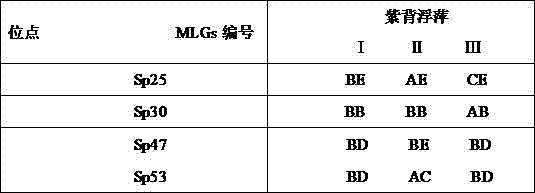Method for screening molecular markers associated with growth of spriodela polyrrhiza roots
A molecular marker, purple-backed duckweed technology, applied in biochemical equipment and methods, microbial determination/inspection, etc., to achieve the effect of fast detection and improved biological treatment efficiency
- Summary
- Abstract
- Description
- Claims
- Application Information
AI Technical Summary
Problems solved by technology
Method used
Image
Examples
Embodiment 1
[0016] The method for screening the growth-related molecular markers of Duckweed root includes clone culture, genomic DNA extraction, design of microsatellite primers, PCR amplification, and data statistics and analysis.
[0017] The composition and concentration of the nutrient solution for plant clone culture are: nitrogen 0.3~0.4g / L, phosphoric anhydride 0.1~0.15 g / L, potassium oxide 0.16~0.23 g / L, magnesium oxide 0.01~0.015 g / L and sulfur 0.012 ~0.02 g / L. The above-mentioned nutrient solution can comprehensively provide the macroelements and trace elements required for the growth of the purple-backed duckweed, the asexual reproduction speed is fast, the probability of gene mutation is low, and a large number of plants with the same gene can be obtained, and the sample size is sufficient.
[0018] The plant clones were cultured indoors in a light incubator for 50-70 days, the culture conditions were 22.5-23.5°C, the humidity was 73-83%, the light intensity was 1800-2200lux,...
Embodiment 2
[0023] The method for screening the growth-related molecular markers of Duckweed root includes clone culture, genomic DNA extraction, design of microsatellite primers, PCR amplification, and data statistics and analysis.
[0024] The composition and concentration of the nutrient solution for plant clone cultivation are: nitrogen 0.32 g / L, phosphoric anhydride 0.12 g / L, potassium oxide 0.19 g / L, magnesium oxide 0.012 g / L and sulfur 0.016 g / L. The above-mentioned nutrient solution can comprehensively provide the macroelements and trace elements required for the growth of the purple-backed duckweed, the asexual reproduction speed is fast, the probability of gene mutation is low, and a large number of plants with the same gene can be obtained, and the sample size is sufficient.
[0025] The plant clones were cultivated indoors for 60 days in a light incubator, the culture conditions were 23°C, humidity 78%, light intensity 2000lux, and light-dark time 16:8h. Under the above cultur...
Embodiment 3
[0030] The method for screening the growth-related molecular markers of Duckweed root includes clone culture, genomic DNA extraction, design of microsatellite primers, PCR amplification, and data statistics and analysis.
[0031] The composition and concentration of the nutrient solution for plant clone cultivation are: nitrogen 0.32g / L, phosphoric anhydride 0.12g / L, potassium oxide 0.2g / L, magnesium oxide 0.013g / L and sulfur 0.017g / L. The above-mentioned nutrient solution can comprehensively provide the macroelements and trace elements required for the growth of the purple-backed duckweed, the asexual reproduction speed is fast, the probability of gene mutation is low, and a large number of plants with the same gene can be obtained, and the sample size is sufficient.
[0032] The number of roots / piece, total root length / piece and average root length / piece were counted for each plant (leaves connected) in different culture lines.
[0033] Microsatellite primers were: Sp25: F: ...
PUM
 Login to View More
Login to View More Abstract
Description
Claims
Application Information
 Login to View More
Login to View More - R&D
- Intellectual Property
- Life Sciences
- Materials
- Tech Scout
- Unparalleled Data Quality
- Higher Quality Content
- 60% Fewer Hallucinations
Browse by: Latest US Patents, China's latest patents, Technical Efficacy Thesaurus, Application Domain, Technology Topic, Popular Technical Reports.
© 2025 PatSnap. All rights reserved.Legal|Privacy policy|Modern Slavery Act Transparency Statement|Sitemap|About US| Contact US: help@patsnap.com


